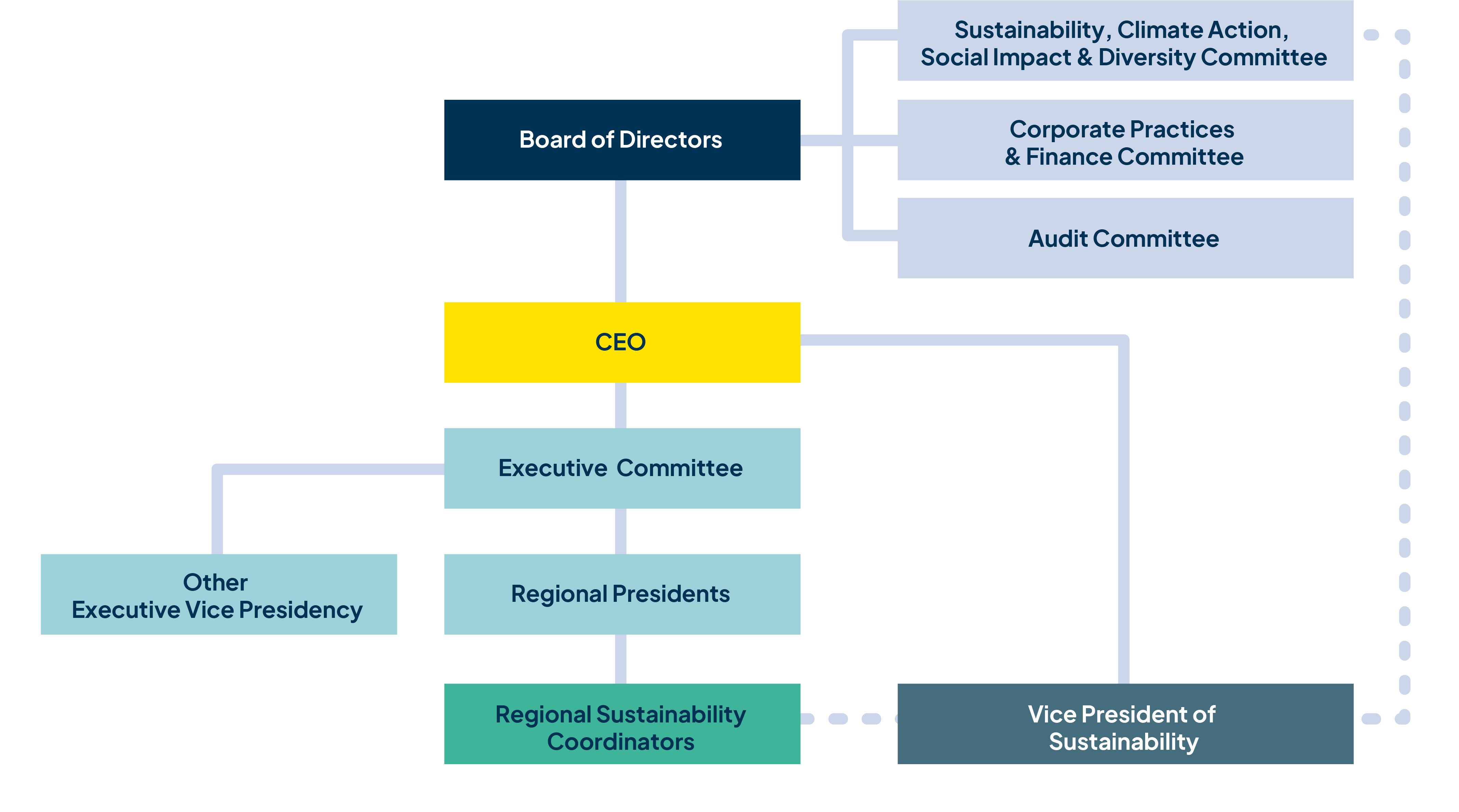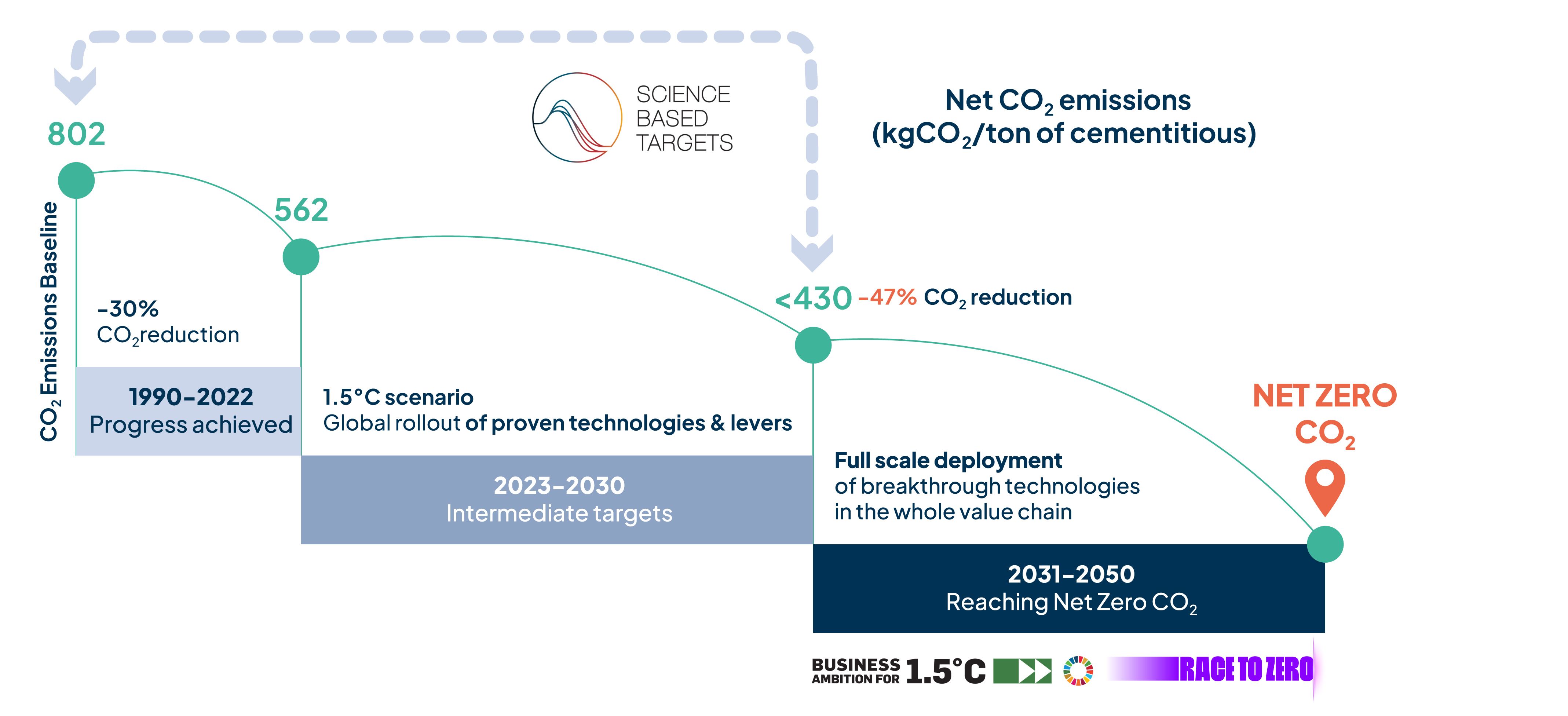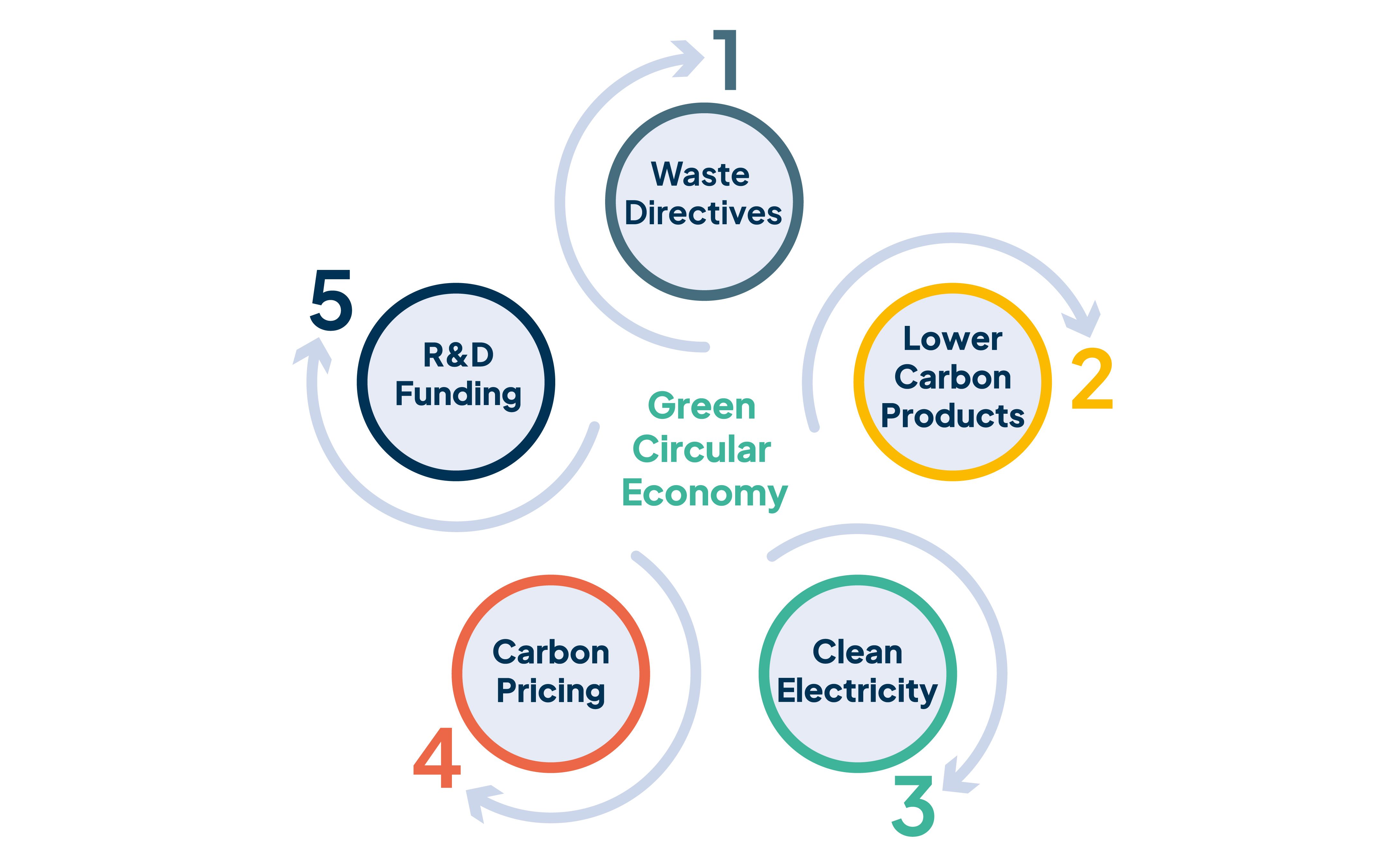Introduction
A leading player in the construction materials industry, Cemex is also one of the first cement producers to have its 2030 and 2050 net-zero targets validated against the Science-Based Targets initiative’s (SBTi) 1.5°C scenario methodology. A board-level commitment to apply best practice and the most stringent standards to its global operations is helping Cemex to accelerate climate action.
Company information and governance structure
CEMEX S.A.B. de C.V. (Cemex) is a global construction materials company, headquartered in Mexico, offering cement, ready-mix concrete, aggregates, and urbanisation solutions in growing markets around the world. Its multinational workforce is focused on providing a high-quality customer experience enabled by digital technologies.
Cemex’s board of directors (‘the Board’) is responsible for overseeing the organisation’s transition to net zero. A dedicated board-level Sustainability Committee was first formed in 2014 and, in 2022, was renamed to reflect an expanding focus on a wider set of sustainability issues as the Sustainability, Climate Action, Social Impact and Diversity Committee (referred here as ‘Sustainability Committee’).
Cemex’s CEO, supported by the Executive Committee, defines the sustainability strategy. The Board, through the Sustainability Committee, reviews such strategy and sets the organisation’s direction of travel on sustainability issues: evaluating progress, reviewing and agreeing policies, and assessing risks and mitigation pathways. The Board also monitors the sustainability-education initiatives (branded ‘Cemex University’) and, together with the Corporate Practice and Finance Committee, implementation of the organisation’s Sustainability-Linked Financing Framework. Cemex shareholders elect members of the Sustainability Committee every year for a one-year period.
The Sustainability Committee and the Board are advised by Cemex’s Vice Presidency of Sustainability. The organisation’s central sustainability function is responsible for implementing initiatives and embedding them across the business, supported by sustainability coordinators in all regions where Cemex operates.
While some board members have deep knowledge of sustainability issues, all board members join a tailored Cemex University module helping to ensure a shared foundation in sustainability issues. In addition, topical sustainability issues are regularly presented to the Board.

Figure 1. Cemex’s sustainability governance structure
The challenge
The cement industry is estimated to be responsible for as much as 8% of global CO2 emissions. The challenge for cement producers, such as Cemex, is to reduce these emissions whilst working to meet a growing demand for cement to support infrastructure needs, particularly in developing economies.
Cemex has a presence in more than 50 countries, meaning it has to operate under vastly different regulatory environments, particularly when it comes to sustainability. For example, Europe has a defined a net-zero goal and has more stringent CO2 emissions and trading regulations than other markets where Cemex operates.
The solution
Future in Action
Future in Action is Cemex’s plan to integrate sustainability into its business. The plan is defined and led by the CEO, and sets out an approach to addressing the above-mentioned challenges. It details the organisation’s vision to become a net-zero company through climate action, management of natural resources and reuse of materials following the principles of a circular economy. This vision pulls together the diverse strands of action, clearly communicating to employees and stakeholders how the different strands interrelate and support the organisation’s vision to decarbonise. The Board and Sustainability Committee are responsible for overseeing progress against the goals set out in the Future in Action plan.
To implement the strategy, Cemex works with a wide range of suppliers and services providers. Their skills and experience can vary significantly depending on how advanced climate regulation is in the market where the supplier operates.
Cemex has set a target to reduce its direct net CO2 emissions by 47% (from a 1990 baseline) by 2030 and to reach net zero CO2 emissions by 2050 across the company. Both targets have been validated against SBTi’s 1.5°C scenario.

Figure 2. Cemex’s net-zero pathway (Note: metric tons)
The highest common denominator
As Cemex expanded its operational base in Europe, with the last major acquisition in 2005, the company made a strategic decision in 2014 to apply European sustainability standards and best practices across its global operations. Since then, the Sustainability Committee at the Board and the management team have insisted that the organisation continually seeks to identify the highest operational standard of its markets and bring all operations up to that level. This has helped the organisation to be better prepared for, and ensure compliance with, evolving regulations.
The Board regards the transition to net zero as a strategic opportunity for the organisation. It also considers effective climate action as an important strategic differentiator. For example, at each quarterly meeting of the Sustainability Committee, the management team presents an update on emerging climate risks and opportunities for the organisation. In 2022, this included a presentation of the SBTi’s new strategy for 1.5°C-aligned emissions reduction targets. Recognising that stakeholders, particularly investors, are singling out organisations that have clear and validated net-zero targets, Cemex pushed to be one of the first in its sector to have climate targets validated by the SBTi.
Promoting a Green Economy
Cemex has made faster progress towards its decarbonisation goals in markets where there is a clear roadmap and structured regulatory landscape supporting the net-zero transition, such as the European Union.
The Board’s guidelines on applying a best-in-class approach globally has also shaped the organisation’s advocacy efforts and internal processes to encourage regulatory change and create business opportunities. Notably, as part of ‘Promoting a Green Economy’ (one strand of its Future in Action plan), Cemex campaigns for legislation - supporting decarbonisation of the built environment sector - that has been effective in a country or region to be adopted more generally in other parts of the world.
For example, the European Waste Framework Directive makes clear that sending waste to landfill should be a last resort. This has created a favourable business environment for Cemex in Europe. Firstly, it has increased the supply of recycled concrete from old buildings that Cemex can use in its products. It has also opened up opportunities to turn waste materials into alternative fuels, reducing reliance on fossil fuels.
There is currently no equivalent legislation in Mexico, meaning waste concrete and building materials have virtually no commercial value and are sent straight to landfills. Cemex has been working with Mexico City authorities to develop a Zero Waste Plan, creating a market for alternative fuels and opportunities for its Regenera subsidiary, which specialises in reusing materials as part of a circular economy.
Following a review of this initiative, Cemex’s Sustainability Committee recommended the strategy be rolled out more broadly. Regenera now manages waste contracts in Querétaro, Mexico and Bogotá, Colombia; and has signed a new partnership to manage 50% of the non-recyclable municipal waste of Puebla, Mexico.

Figure 3. Cemex’s 5 advocacy priorities for a green circular economy
Sustainable investment
Since 2020, Cemex’s Board has overseen the organisation’s efforts to link its financing structures and investment decisions to its climate goals, starting with implementation of an internal carbon pricing. Cemex has applied the locally-mandated carbon price, e.g. under the European Union Emissions Trading System (EU ETS), or a minimum carbon price of $25 per metric ton of CO2 in all markets without an ETS to ensure that the carbon impact is factored into any investment decision.
This was followed in 2021 with the launch of Cemex’s Sustainability-Linked Financing Framework, which sets out guiding principles for issuing new sustainability-linked financial instruments, including bonds and loans. The Framework was updated in 2023 to reflect the organisation’s more ambitious 2030 decarbonisation targets following validation by the SBTi.
In 2022, the Board authorised Cemex to issue financial solutions linked to Cemex’s new Green Financing Framework - including bonds and loans - to finance, or refinance, eligible projects with a positive environmental impact. These decisions are authorised on the basis that any financing frameworks align with best practice and policies are independently validated where possible. For example, Cemex’s Sustainability-Linked Financing Framework aligns with both the Sustainability-Linked Bond Principles 2023 and the Sustainability-Linked Loan Principles 2023. The Framework has also been evaluated by Sustainalytics to ensure it complies with both standards, including a requirement that the Board holds responsibility for overseeing progress against the organisation’s climate strategy, as well as sustainability-related financing decisions.
This approach creates a virtuous circle. Approximately 42% of the organisation’s debt financing is linked to its climate goals, meaning there are potential penalties, such as higher interest rates on loans, for failure to achieve climate targets. Consequently, climate action attracts increased attention at board level, further stimulating progress against corporate goals. The organisation is aiming for 50% of its debt financing to be linked to sustainability goals by 2025 and 85% by 2030.
Setting the tone
While investor demand has been an important factor in accelerating the organisation’s decarbonisation progress, the biggest driver for Cemex is a clear vision and commitment to sustainability from the CEO and the Board. Cemex was the first company in Mexico to file an integrated annual and sustainability report with the US Securities and Exchange Commission. This shows that the Board and the wider organisation are prepared to be scrutinised under a tougher law, for example, having their decarbonisation targets audited and being held accountable for progress against them.
Internally, the vision set out in Future in Action establishes a defined path for the business, helping individual employees to understand their role in the transition. The Board is continuously looking at ways to embed responsibilities more formally. All employees currently have a sustainability-related objective which, for more than 4,500 executives (approximately 10% of the workforce), is linked to their variable remuneration.
Progress and impact
By the end of 2022, Cemex had reduced its greenhouse gas emissions by 30%: from 802 kg/metric ton CO2 in 1990 to 562 kg/ton CO2. In particular, progress has accelerated significantly over the past two years. Emissions have come down by 9% between 2020-2022, equivalent to the cumulative emissions reduction in the previous 10 years (against the same 1990 baseline).
Cemex has already reduced the proportion of clinker (a key ingredient in cement) in its products to 73.7%, whilst ensuring it maintains the same product performance, almost surpassing its 2025 target of 74%. Production of clinker requires high temperatures and is associated with high energy consumption and CO2 emissions, so cutting the volume of clinker needed has a significant impact on overall emissions.
Meanwhile in its waste management operations, Cemex has processed 27m tons of material for reuse, equivalent 67 times the volume of unrecyclable material it has produced. It’s target is to reach 41m tons by 2030.
Conclusion
Cemex is focused on applying best practices and the most stringent standards to all of its business units. This approach, coupled with the CEO’s strategic vision and the Board’s continued monitoring, has enabled the organisation to achieve global compliance as regulation evolves and to deliver significant reductions in greenhouse gas emissions. Engagement with regulators in the different countries in which the organisation operates has also permitted Cemex to identify opportunities and accelerate its path to net zero. A continued drive to accelerate progress, with increasing investment to identify the cement technologies of the future, will be key to ensuring the delivery of the organisation’s net-zero goals and longer-term prosperity.



